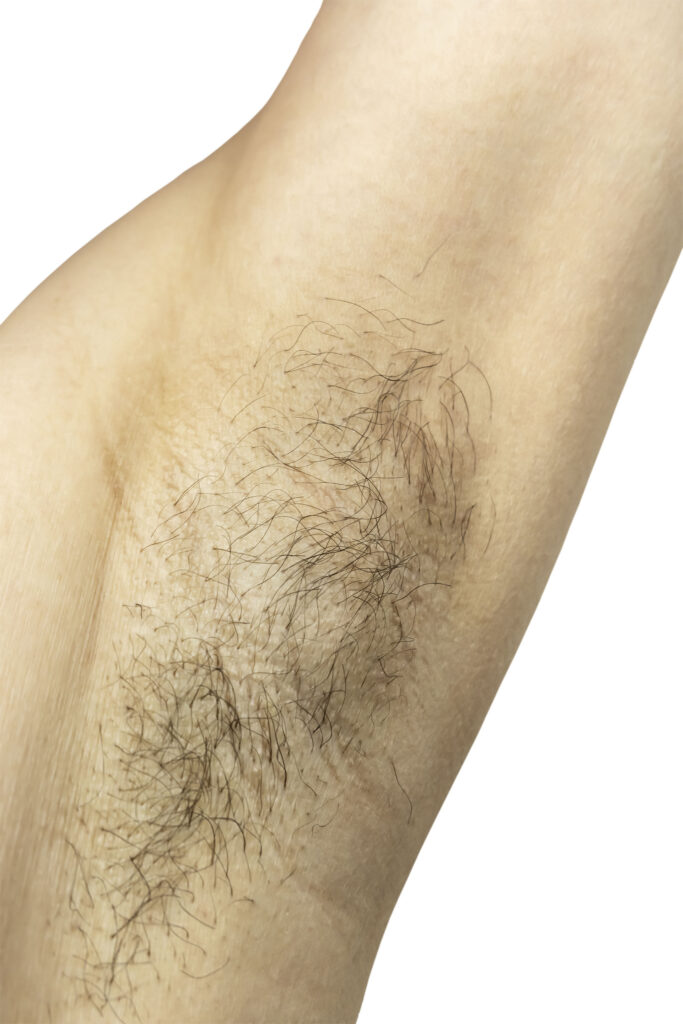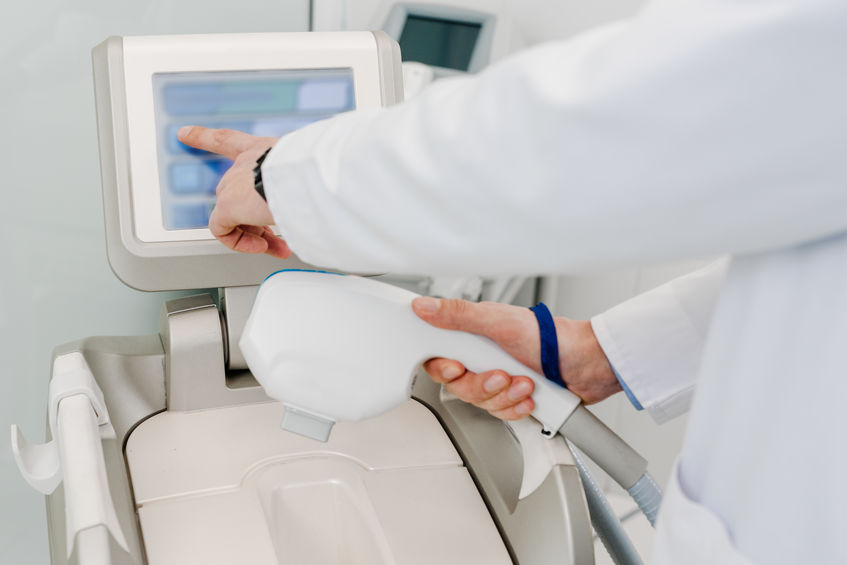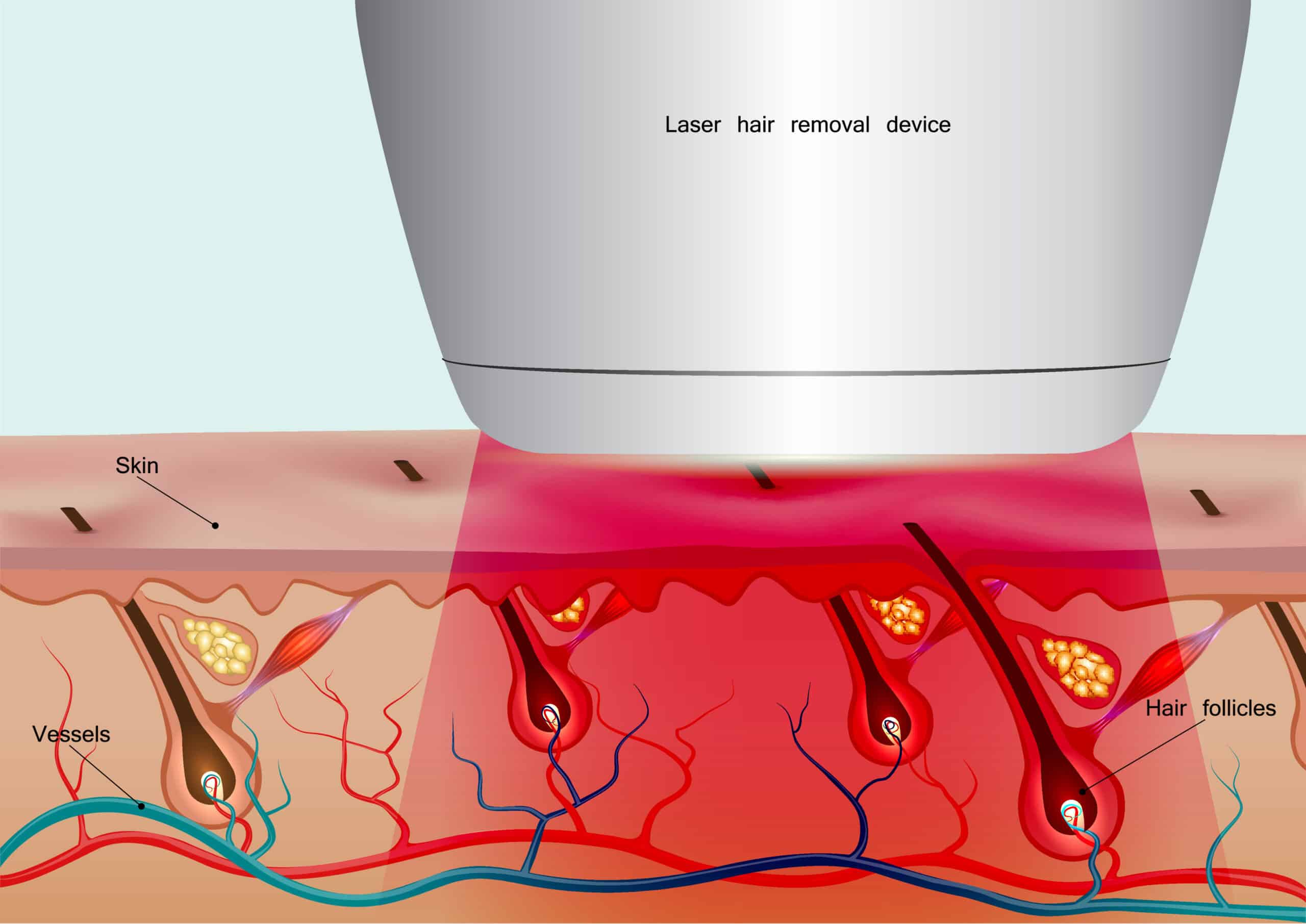Laser hair removal marketing usually refers to the treatment pain being similar to someone flicking a rubber band against your skin. But anyone who has had laser removal done knows that it’s not really that simple.
Laser hair removal treatment hurts more on the underarms and bikini area where skin is soft. The more hair you have and the closer it is to bones such as the collarbone also increases the pain. The type of laser being used and the skill of the person doing the work also matters. Laser machines with a cooling feature can minimize pain.
In my experience, there are a number of factors that need to be considered when determining the expected pain prior to a laser hair removal session.
Factors that determine how pain laser hair removal causes
The pain of laser hair removal is generally dependent on a number of criteria including the following:
Quality of the practitioner
A quality and well-trained laser hair removal practitioner knows how to properly set the machine to meet the skin type and personal attributes of the patient. If the setting is too high, it can lead to excessive pain and in the extreme, burning and scarring of the skin.
The most common side effects of laser hair removal are temporary: Reddened, sensitive skin and some stinging or a warm feeling on the area that was treated are typical. They generally only last a few hours at most in my experience. Anything more than that and you might need to have a chat with the person doing the laser hair removal work and preferably while the treatment is being done before damage is done.
Part of the onus falls on the patient to let the hair removal practitioner know if the pain is too much. Alternatively if you can’t feel anything it could mean the setting of the laser is too low and thus ineffective.
Amount of hair to be removed
The more hair to be removed, the more pain you will feel. The laser travels down the shaft of the hair into the follicle so the more hairs being zapped, the more pain you will feel. Sparsely covered areas often cause little to no pain whatsoever.
The laser is absorbed by the hair itself but some hair colors simply don’t respond well to laser as they are unable to absorb light very well. This includes gray, red, blond and white hairs which are difficult if not impossible to treat with laser.
Type of laser being used
These days, there are different types of laser hair removal technologies that meets the need of a wider variety of skin tones and hair colors than in the past. Some older style laser models can hurt more than others.
The Nd:Yag laser has newer machines available but due to its high wavelength, older models may hurt some patients with burns, scars and skin discoloration rare but possible side effects.
Older laser machines may still use cooling gel applied directly to the skin before treatment to protect the skin. The gel has to be applied correctly by the practitioner and isn’t as effective as newer laser machines that use cooling features instead (we’ll talk about that below).
Proximity to bones
The closer the bones are to the surface of the skin being treated, the more you will feel the pain. When I was having my shoulder hair removed, I noticed that the most pain I felt was around the collarbone area as the bones are very close to the surface of the skin.
Although I never had my ankles treated, the bones are very close to the skin there too so expect that this area would produce more pain than others.
I felt more pain around in the collarbone area than any other body part except for perhaps the back of the neck area which was also quite painful at times. The difference was that the next day I could still sometimes feel a stinging sensation on the back of my neck similar to a mild sunburn. The collarbone pain by comparison seemed to be isolated and only hurt as the laser was actually zapping the area in question. The pain subsided quickly.
Your pain threshold
Some people can withstand more pain than others. If you tense up at times, it’s possible you may make the pain seem more than it is especially if you squirm or fidget or get stressed out.
While woman are often believed to be able to withstand more pain than men, men tend to have more, thicker and coarser hair which attracts more light from the laser and thus produces more pain.
Body part being treated
The body part being treated with laser hair removal also has an impact on the pain level. Some body parts have thin skin such as the underarms or the aforementioned back of the neck. Other areas of skin are thicker such as the forearms and stomach. Unwanted hair around bones that are near the surface of the skin tends to produce more pain, too.
Also, it’s possible that women might experience more pain during their period.

Laser hair removal pain level by body part
While the above-mentioned criteria still needs to be considered, the reality is that some body parts hurt more than others given the specific location, thickness of the skin and proximity to bones which can also impact the pain you feel.
| Body part | Pain level | Notes |
| Underarms | Very high | Thin skin and sensitive area with dense hair. |
| Lip | Very high | Thin skin and sensitive area. |
| Bikini | High | Thin skin, sensitive area and coarse, dense hair. |
| Collarbone | High | Bones are very close to the surface of the skin and the laser zapping them produces a sharp pain. |
| Shoulders/Neck | High | Thin skin that can redden with treatment and may sting until the next day. |
| Ankles | High | Very close to the bones and little meat on the skin. |
| Back | Medium | The back is a large area so it largely depends on what specific part: The kidney area tends to be pretty sensitive. |
| Legs | Medium | The skin is thicker although legs may have significant hair to be removed and you may run into the bones issue again. |
| Chest | Medium | Tends to be more sensitive around the edges of the chest than the center of the body. |
| Stomach | Low | Thick skin here helps reduce the pain but if you’re ticklish you might feel that instead. |
| Arms | Low | Thick skin especially on the forearms so arms tend to be able to tolerate the pain well. |
| Chin/Sideburns | Low | Thick skin here and the skin is not as sensitive as other areas. |
The more you are able to relax and not tense up, the better your experience will be.

How to reduce the pain from laser hair removal
Check ahead of time with the clinician who will be doing the laser hair removal regarding specific recommendations that they have regarding shaving, pain medication, etc. Here are a few thoughts regarding what you can do to make your experience less painful and more successful.
Shave before treatment
Unless you are told otherwise, shaving the night before treatment is a good idea but usually not later than the morning of treatment. Laser hair removal targets the follicle so the laser only needs to hit the hair and travel down the shaft to the follicle. The shorter the hair, the less it has to travel and the more powerful the zap which is what you want.
Medication
Some hair removal clinics may suggest taking an antihistamine the night before treatment and possibly the day of treatment to help alleviate pain.
Numbing cream
Ask if your clinic offers or recommends a topical numbing cream either before the laser treatment or after. While Intense Pulsed Light (IPL) and some laser treatments utilize a cooling gel during treatment, a numbing cream might help you feel less discomfort if no gel is used during your chosen treatment.
Laser machine cooling mechanism
Modern laser hair removal machines are more likely to use a built-in cooling mechanism than a cooling gel applied to the skin like IPL. Current cooling technologies are generally classified as either contact cooling or non-contact cooling and further described as active or passive.
Some laser machines use cryogen to cool the skin a second before each pulse of the laser. A puff of the gas is used on the skin directly before it is treated with the laser.
Other laser hair removal machines use air to cool your skin before, during and after treatment in some cases.
Check with each laser clinic you speak with regarding the machines they use and what cooling feature they offer before agreeing to use their services. Research is available that discusses common cooling options and the pros and cons of each.
is available that discusses common cooling options and the pros and cons of each.
Post laser hair removal routine
To avoid pain or irritation immediately after treatment, stay out of the sun and put sunscreen on if the treated areas are exposed to the light.
Also avoid hot showers for at least 24 hours or until reddened, sensitive skin has healed.
Wearing loose fitting clothing over affected areas is helpful, too.
Recent Posts
Laser hair removal may not be as effective for individuals with red hair, as well as those with blonde, gray, or white hair, because the laser targets the pigment (melanin) in the hair follicle....
Laser remains a very popular form of hair removal and for several reasons. While not a permanent hair removal option like electrolysis, the benefit of laser is that it enables you to treat more...


